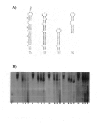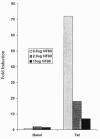Nuclear Factor 90(NF90) targeted to TAR RNA inhibits transcriptional activation of HIV-1
- PMID: 17565699
- PMCID: PMC1910605
- DOI: 10.1186/1742-4690-4-41
Nuclear Factor 90(NF90) targeted to TAR RNA inhibits transcriptional activation of HIV-1
Abstract
Background: Examination of host cell-based inhibitors of HIV-1 transcription may be important for attenuating viral replication. We describe properties of a cellular double-stranded RNA binding protein with intrinsic affinity for HIV-1 TAR RNA that interferes with Tat/TAR interaction and inhibits viral gene expression.
Results: Utilizing TAR affinity fractionation, North-Western blotting, and mobility-shift assays, we show that the C-terminal variant of nuclear factor 90 (NF90ctv) with strong affinity for the TAR RNA, competes with Tat/TAR interaction in vitro. Analysis of the effect of NF90ctv-TAR RNA interaction in vivo showed significant inhibition of Tat-transactivation of HIV-1 LTR in cells expressing NF90ctv, as well as changes in histone H3 lysine-4 and lysine-9 methylation of HIV chromatin that are consistent with the epigenetic changes in transcriptionally repressed gene.
Conclusion: Structural integrity of the TAR element is crucial in HIV-1 gene expression. Our results show that perturbation Tat/TAR RNA interaction by the dsRNA binding protein is sufficient to inhibit transcriptional activation of HIV-1.
Figures






References
-
- Siliciano RF. HIV replication and evolution in patients with highly active antiretrovirus therapy. Retrovirology. 2006;3:S11. doi: 10.1186/1742-4690-3-S1-S11. - DOI
-
- Pido-Lopez J, Burton C, Hardy G, Pires A, Sullivan A, Gazzard B, Aspinall R, Gotch F, Imami N. Thymic Output during Initial Highly Active Antiretroviral Therapy (HAART) and during HAART Supplementation with Interleukin 2 and/or with HIV Type 1 Immunogen (Remune) AIDS Res Hum Retroviruses. 2003;19:103–109. doi: 10.1089/088922203762688603. - DOI - PubMed
Publication types
MeSH terms
Substances
Grants and funding
LinkOut - more resources
Full Text Sources
Miscellaneous

